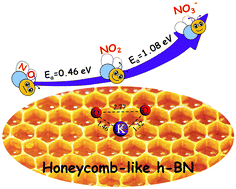The role of potassium in the activation of oxygen to promote nitric oxide oxidation on honeycomb-like h-BN(001) surfaces†
Abstract
Two-dimensional materials have developed rapidly in the field of catalysis, which has made honeycomb-like 2D hexagonal boron nitride (h-BN) considered to be a promising material in the application of catalysis. In this study, potassium (K) modified h-BN(001) surfaces are designed for the first time for the purpose of removal of nitric oxide (NO) via dispersion corrected density functional theory (DFT) computations. The role of K in changing the electronic properties and processes of NO oxidation is investigated in detail. The introduction of K effectively narrows the band gap of h-BN and acts as the surface electron donor on the surface. Importantly, the energy barrier is decreased by 3.45 eV at most along the whole NO oxidation path on K-doped h-BN(001), which is directly ascribed to the spontaneous dissociation of O2 induced by K and efficient charge transfer across the interface. The activation of O2 may be beneficial to other analogous oxidation reactions. With the introduction of K, the energy barrier of NO2 conversion to NO3− is significantly decreased and the desorption of NO2 is inhibited. Hence, NO3− instead of NO2 becomes the main oxidation product on K-modified h-BN. This work may provide new insights into the role of alkali metals in the activation of O2 to facilitate oxidation reactions on 2D materials.



 Please wait while we load your content...
Please wait while we load your content...